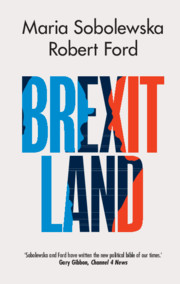Book contents
- Brexitland
- Reviews
- Brexitland
- Copyright page
- Contents
- Figures and tables
- Acknowledgements
- 1 Introduction: How Britain Became Brexitland
- Part I Demographic change and the emergence of new political divides over identity
- Part II Identity conflicts from New Labour to the Coalition
- 5 The Long Divorce: Parties and Voters Parting Ways
- 6 The Identity Conservative Insurgency and the Rise of UKIP
- 7 Change without Recovery: How the Coalition Catalysed Labour’s Demographic Transformation
- Part III Brexitland
- Bibliography
- Index
7 - Change without Recovery: How the Coalition Catalysed Labour’s Demographic Transformation
from Part II - Identity conflicts from New Labour to the Coalition
Published online by Cambridge University Press: 21 September 2020
- Brexitland
- Reviews
- Brexitland
- Copyright page
- Contents
- Figures and tables
- Acknowledgements
- 1 Introduction: How Britain Became Brexitland
- Part I Demographic change and the emergence of new political divides over identity
- Part II Identity conflicts from New Labour to the Coalition
- 5 The Long Divorce: Parties and Voters Parting Ways
- 6 The Identity Conservative Insurgency and the Rise of UKIP
- 7 Change without Recovery: How the Coalition Catalysed Labour’s Demographic Transformation
- Part III Brexitland
- Bibliography
- Index
Summary
In this chapter we describe the second important electoral development of the Coalition period: the ‘reshuffle on the left’. Coalition with the Conservatives unravelled the Liberal Democrats’ electoral alliance of identity liberals, protest voters and tactical anti-Tory voters. More than one voter in eight in England and Wales switched from the Liberal Democrats to other parties during the Coalition. Protest-motivated Liberal Democrat supporters switched largely to UKIP, but the biggest shift was the migration of identity liberals to Labour, tipping the balance of the Labour electoral coalition. The traditional alliance of ethnic minority voters with Labour was also reinforced in this period as Muslim voters alienated by the Iraq War returned to the Labour fold. As white school leavers alienated by New Labour and angry about immigration shifted in large numbers from Labour to UKIP, the growing strength of identity liberals within the Labour coalition was accelerated. As a result, the 2015 Labour electorate, though similar in size to that of 2010, was dramatically different in composition. The traditional party of the workers was, for the first time, drawing more support from graduates and ethnic minorities than from white school leavers. This was a new Labour Party.
Keywords
- Type
- Chapter
- Information
- BrexitlandIdentity, Diversity and the Reshaping of British Politics, pp. 189 - 214Publisher: Cambridge University PressPrint publication year: 2020

